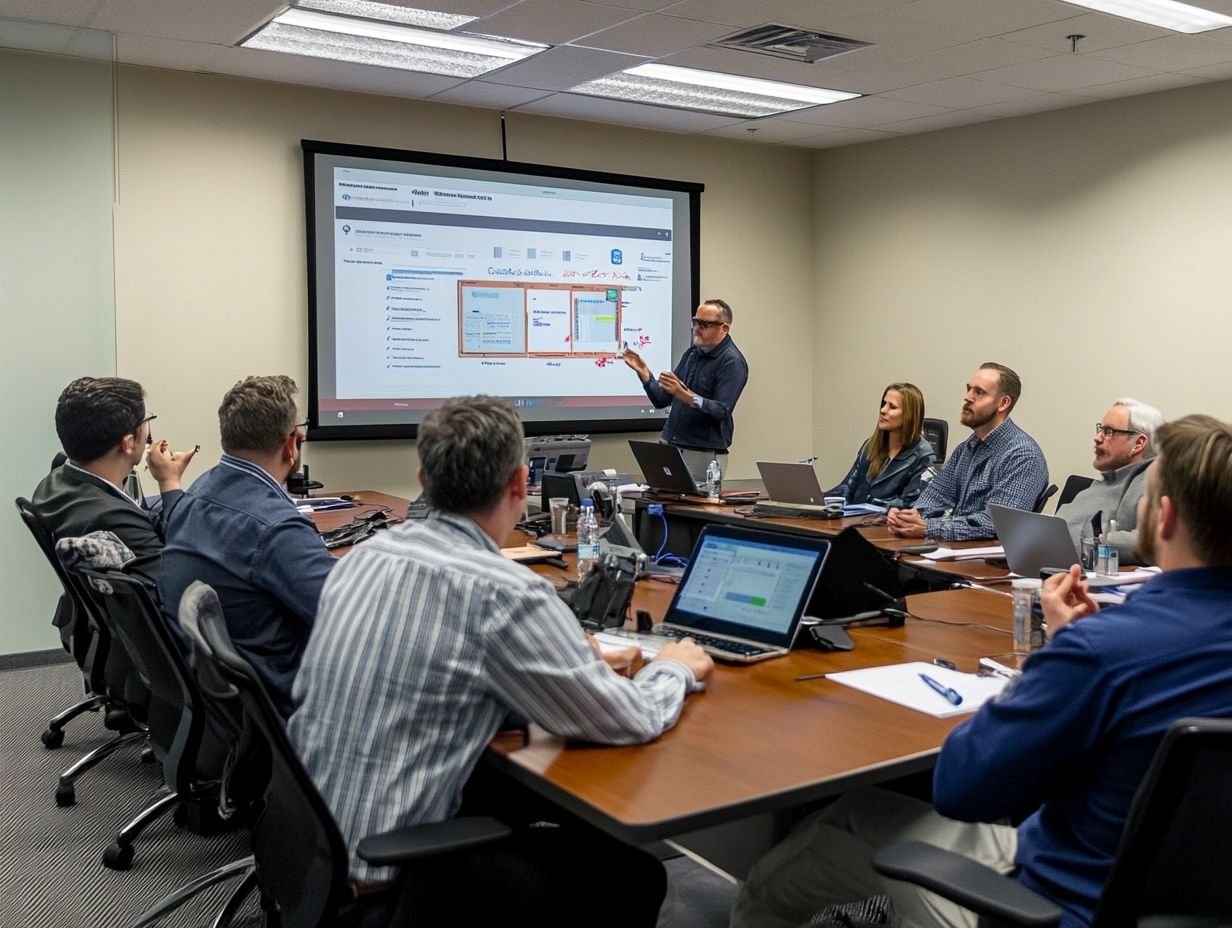the importance of employee training in managed security
In today s digital landscape, where cyber threats continuously evolve, it s vital to prioritize your security measures.
Managed security services form a crucial line of defense. However, without properly trained employees, even the most advanced systems can falter.
By grasping the fundamentals of managed security and recognizing the vital role employee training plays, you can significantly bolster your organization s resilience.
This article will show you the types of training necessary for protecting sensitive information, the advantages of having a well-trained staff, and best practices for rolling out an effective training program.
Learn how investing in employee training can boost your security defenses and effectively mitigate risks.
Contents
- Key Takeaways:
- The Role of Managed Security in Businesses
- Why Employee Training is Crucial
- Types of Employee Training for Managed Security
- Benefits of Employee Training in Managed Security
- Implementing an Effective Employee Training Program
- Frequently Asked Questions
- What is the importance of employee training in managed security?
- How does employee training in managed security benefit a company?
- What topics should be covered in employee training for managed security?
- How often should employee training for managed security be conducted?
- Why is it important to involve all employees in managed security training?
- What are some effective methods for employee training in managed security?
Key Takeaways:

Employee training is crucial in managed security as it improves security measures and highlights the importance of threat analysis in managed security, ultimately reducing the risk of data breaches.
Technical training and security awareness training are two key types of employee training needed for effective managed security, highlighting the importance of incident reporting in managed security.
Implementing an effective employee training program requires key components and best practices to ensure success.
The Role of Managed Security in Businesses
Managed security serves as a cornerstone for your business, tackling complex cybersecurity issues with a methodical approach.
In today s fast-paced digital environment, grasping the importance of managed security is crucial for any organization aiming to shield its assets from cyber threats.
Adopt comprehensive security practices to cultivate a strong security culture. This ensures you adhere to regulations like GDPR and bolsters your incident response capabilities.
As cyber risks grow, focusing on cybersecurity education and seamlessly integrating risk management strategies is imperative to protect sensitive data and uphold consumer trust.
Understanding the Basics of Managed Security
Understanding the fundamentals of managed security is essential for organizations aiming to effectively mitigate cybersecurity risks.
Managed security encompasses a range of strategies and frameworks designed to protect sensitive information and ensure compliance with relevant regulations.
By leveraging well-structured security frameworks, you can establish a comprehensive approach to safeguarding your assets.
Tools like intrusion detection systems, which help detect unauthorized access, firewalls that block harmful traffic, and endpoint protection are vital components in this endeavor.
However, no strategy can reach its full potential without an informed workforce. Research shows that human error accounts for a significant portion of security breaches, highlighting the critical need for continuous employee training.
Implementing regular security awareness programs equips your team with the knowledge to identify potential threats. This also encourages behavioral changes that contribute to a more vigilant workplace.
Current statistics reveal that organizations with robust employee training measures experience fewer security incidents. This reaffirms the importance of cultivating an educated and proactive workforce.
Why Employee Training is Crucial
Employee training plays a pivotal role in cultivating a proactive security culture. This effectively minimizes the risk of cyber threats such as phishing attacks and data breaches.
It s essential for organizations to acknowledge that the human element is fundamental in sustaining security behaviors and fulfilling compliance requirements.
The Impact of Employee Knowledge on Security
The significance of employee knowledge on security is paramount, as you become part of a human firewall against potential security incidents.
When you invest in enhanced cybersecurity education and cultivate security awareness, you can drive significant behavioral changes that fortify your organization s security culture.
Equipped with the right tools and information, you are far less likely to succumb to phishing attacks and other cyber threats. This understanding fosters a proactive environment where you and your colleagues feel a sense of responsibility for safeguarding sensitive data.
Consider companies that have implemented comprehensive training programs like the renowned ‘Cybersecurity Awareness Month’ initiatives. They have observed marked reductions in security breaches.
By championing a culture of continuous learning and maintaining open lines of communication, you can help your organization effectively lower its risk profile and bolster overall resilience against cyber threats.
Types of Employee Training for Managed Security

You ll find that there are several types of employee training tailored for managed security, each essential for constructing a robust security framework.
It’s crucial for organizations like yours to emphasize both technical training and security awareness training, ensuring your workforce is well-prepared to tackle today’s cyber threats.
Technical Training
Technical training is an essential pillar of your cybersecurity education, honing the practical skills you need for effective incident response and the adept use of various security tools. By mastering technical aspects such as password security and multi-factor authentication, you enhance your ability to protect your organization s assets from cyber threats.
Beyond these foundational skills, your training delves into firewall management, ensuring that network boundaries are effectively monitored to thwart potential attacks. Secure browsing practices are also highlighted, equipping you with the knowledge to navigate the internet safely while steering clear of phishing attempts and malicious websites.
Recognizing malware can significantly reduce the risk of a breach.
Staying updated with emerging cybersecurity trends is important, as is understanding compliance requirements. This knowledge gives you the power to tailor your strategies for effective risk management, strengthening your organization against the ever-evolving landscape of threats.
Security Awareness Training
Security awareness training is essential for fostering a proactive mindset within employees, giving them the power to identify and respond effectively to potential threats such as phishing attacks and data breaches.
This form of cybersecurity education equips you with the knowledge needed to enhance your security behaviors and adhere to essential regulations. By integrating interactive elements and real-world scenarios, these programs cultivate a deeper understanding of the security risks you face.
Common topics covered include:
- Recognizing phishing attempts
- Securing personal and organizational devices
- Understanding the importance of strong password practices
As you and your colleagues become more vigilant, the collective security posture of your organization strengthens, significantly diminishing the likelihood of successful attacks. This training not only fulfills compliance requirements but also creates a culture of security awareness, enabling teams to work with confidence while mitigating the risks associated with human error.
Benefits of Employee Training in Managed Security
Employee training in managed security presents a wealth of benefits, notably enhancing security measures and markedly reducing the risk of data breaches. By investing in cybersecurity education, you can foster a resilient security culture within your organization, giving your employees the power to take an active role in proactive risk management.
This approach dramatically strengthens your defenses and cultivates a workforce that is vigilant and informed, ready to tackle potential threats head-on.
Improved Security Measures
Improved security measures stemming from effective employee training are essential in today s digital landscape, where organizations face incessant cyber threats. Training equips you to identify vulnerabilities and respond appropriately to security incidents, thereby enhancing your overall risk management strategy.
Incorporating practical scenarios into your training modules fosters a culture of vigilance, encouraging you and your colleagues to stay alert to potential breaches. Consider the success stories of companies like Bank of America and Microsoft, which have implemented comprehensive security awareness programs, leading to a significant reduction in phishing-related incidents.
By instilling a sense of responsibility and giving staff the power to meet compliance requirements, these organizations have cultivated a more resilient security posture. Regular refreshers and tailored training strategies ensure that you remain informed about the latest threats and best practices, ultimately contributing to a more secure workplace environment.
Start your training today to empower your team against cyber threats!
Reduced Risk of Data Breaches

Reduced risk of data breaches is one of the most significant advantages gained from comprehensive employee training in managed security.
By educating your team on the dangers of phishing attacks and the best practices for data protection, you can effectively minimize vulnerabilities within your organization. This proactive approach enhances your workforce’s ability to recognize and report suspicious activities.
Furthermore, it fosters a culture of security mindfulness that permeates throughout the entire organization.
For instance, companies that implement regular training and simulation exercises often report a notable decline in incidents. This clearly demonstrates the direct impact that informed employees have on safeguarding sensitive information.
When your staff feels empowered and knowledgeable about their roles in maintaining security, they become the first line of defense. This significantly strengthens your organization s overall security posture.
Implementing an Effective Employee Training Program
Implementing an effective employee training program demands a multifaceted approach that includes security awareness, best practices, and diverse training methods tailored to your organization’s specific needs.
It s crucial to develop a program that aligns with certifications that show your team understands security practices and compliance requirements to ensure success.
Key Components and Best Practices
Key components and best practices of an effective employee training program include setting clear objectives, utilizing engaging training methods, and implementing regular assessments to gauge knowledge retention.
By prioritizing security awareness and ensuring robust incident response capabilities, you can significantly enhance your organization’s cybersecurity posture.
For a comprehensive training experience, it’s essential to incorporate curriculum design that aligns with current industry standards and practices.
Employee engagement strategies, such as interactive workshops and real-world scenario simulations, greatly enhance participation and improve information retention.
Routine updates to training materials are essential to keep pace with evolving technologies and threats. This ensures employees are equipped with the most relevant knowledge to navigate today’s fast-paced work environment.
Frequently Asked Questions
What is the importance of employee training in managed security?
Employee training in managed security is crucial for ensuring the safety and security of a company’s sensitive information and assets. It helps employees understand potential threats and how to prevent them, as well as the importance of regular audits in managed security to properly handle and respond to security incidents.
How does employee training in managed security benefit a company?

By providing employees with the necessary knowledge and skills, training in managed security can significantly reduce the risk of data breaches and cyber attacks. This can save a company from potential financial losses, damage to its reputation, and legal consequences.
What topics should be covered in employee training for managed security?
Employee training for managed security should cover a range of topics, such as identifying and responding to phishing scams, understanding the importance of strong passwords, recognizing potential malware and viruses, and how to properly handle and protect sensitive information.
How often should employee training for managed security be conducted?
It is recommended to conduct employee training for managed security on a regular basis, at least once a year. However, it may also be beneficial to offer ongoing training and updates as new threats and security measures emerge.
Why is it important to involve all employees in managed security training?
All employees, regardless of their role or position, play a part in maintaining the security of a company’s information. By involving all employees in managed security training, the overall security posture of the company can be strengthened, and potential vulnerabilities can be identified and addressed.
In conclusion, investing in employee training for managed security is not just a necessity; it s a strategic move that can protect your organization s most valuable assets. Act now to boost your security training!
What are some effective methods for employee training in managed security?
Unlock your team’s potential with dynamic training methods! Effective approaches include interactive workshops, online courses, simulations, and hands-on exercises.
Regular feedback is key to ensuring that knowledge is retained and applied in real-world situations.






